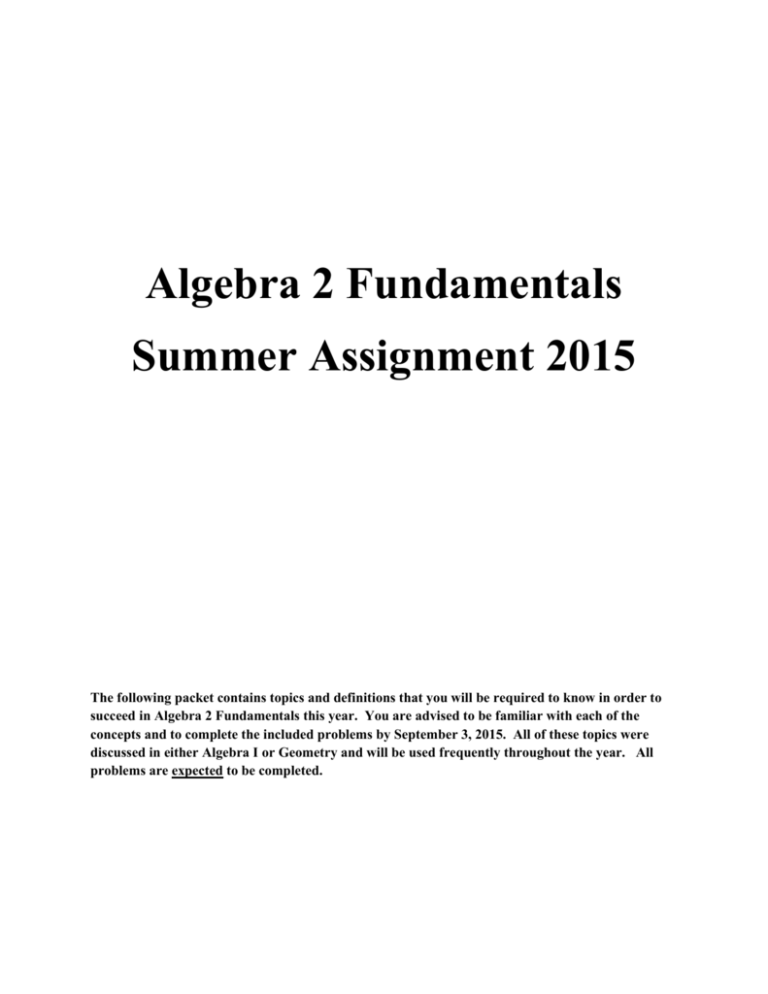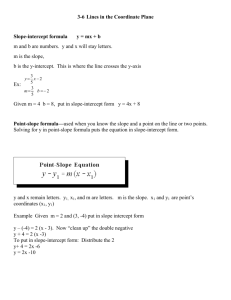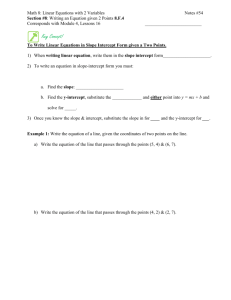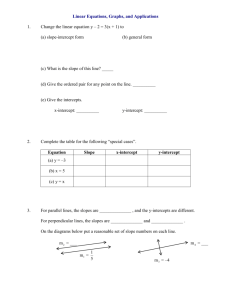Algebra 2 Fundamentals Summer Assignment 2015
advertisement

Algebra 2 Fundamentals Summer Assignment 2015 The following packet contains topics and definitions that you will be required to know in order to succeed in Algebra 2 Fundamentals this year. You are advised to be familiar with each of the concepts and to complete the included problems by September 3, 2015. All of these topics were discussed in either Algebra I or Geometry and will be used frequently throughout the year. All problems are expected to be completed. Algebra 2 Fundamentals Summer Assignment Due: Wednesday, September 11, 2013 Please look over the following review topics and complete the exercises. These topics will help you begin your study of Algebra 2. They are review topics and will not be covered in length during the start of the school year. You should also look into buying a graphing calculator for this course. It is suggested that you purchase a TI-83 Plus. These can be bought for around $90 during back to school sales. Section 1: Functions Function: A function is a relation in which each element of the domain is paired with exactly one element of the range. Vertical line test: If you draw a vertical line through any graph and it only crosses the graph once, then the relation is a function. Linear Equations A linear function is a function where the highest power of x is 1. You have seen these functions in many forms. Some of the common forms are y = mx + b (slope-intercept form) and Ax + By = C (standard form). Notice in both forms the exponent on x is 1. Every linear function has an x and y intercept. x – Intercept: Where a function crosses the x – axis. y – Intercept: Where a function crosses the y – axis. Slope is a key concept to consider when thinking of linear functions. Slope is the “m” in the y = mx + b and is defined to be –A/B for standard form of a line. Here are some definitions of slope. 𝑠𝑙𝑜𝑝𝑒 = 𝑚 = 𝑣𝑒𝑟𝑡𝑖𝑐𝑎𝑙 𝑐ℎ𝑎𝑛𝑔𝑒 𝑟𝑖𝑠𝑒 𝑦2 − 𝑦1 = = ℎ𝑜𝑟𝑖𝑧𝑜𝑛𝑡𝑎𝑙 𝑐ℎ𝑎𝑛𝑔𝑒 𝑟𝑢𝑛 𝑥2 − 𝑥1 Positive slopes increase from left to right. Negative slopes decrease from left to right. Positive slope M = 2 or 2/1 Negative slope m = -1/2 If a line has a slope of zero, it is horizontal and has the equation y = b If a line has an undefined slope it is vertical and has the equation x = c Parallel lines have the same slopes. Perpendicular lines have slopes that are opposite reciprocals. (opposite-different sign; reciprocal-flip fraction) To write an equation of a line, there are many methods: Point-slope formula: y – y1=m(x – x1) Slope-Intercept formula: y = mx + b To graph a linear equation, start at the y-intercept and use the slope to move to the next point. Graph each equation. (Hint: put the equations in slope-intercept form first!!) −1 𝑥 3 1) y = 3x – 2 2) 𝑦 = 3) 5x – 4y = 20 4) y – 2x = -5 5) 𝑦 + 3 = −3 𝑥 4 +4 6) y – 5 = 4x Find the slope of the line through the following points. 6) (-2, 5) and (8,-3) 7) (5,4) and (-1,-6) 8) (2,5) and (2, -7) 9) (4,-3) and (-2,-3) 12) x = -4 13) y = 9 Find the slope of the line given the following equations. 10) y = -2x – 7 11) y – 3x = -2 14) 4x + 2y = -6 15) 5x – y = -8 Write the equation of the line given the following. Write the equation in slope-intercept form, y = mx+b This is m This is x and y m 2 5 16) slope = -3 through the point (-2,5) 17) slope = through the point (-1, -6) 18) Through the points (-2,5) and (5,8) 19) Through the points (-3,7) and (5,7) Section 2: Simplifying Algebraic Expressions The difference between an expression and an equation is that an expression doesn’t have an equal sign. Expressions can only be simplified, not solved. Simplifying an expression often involves combining like terms. Terms are like if and only if they have the same variable and power or if they are constants. Simplifying expressions also refers to substituting values to get a resultant value of the expression. Simplify the following expressions by combining like terms. 2.) 𝑥 2 + 𝑥 2 + 𝑥 + 𝑥 1.) 3 + 2𝑦 2 − 7 − 5𝑥 − 4𝑦 3 + 6𝑥 3.) 4(3𝑥 − 2𝑥 3 + 5) − 6𝑥 4.) 𝑥(2𝑥 − 3𝑥 4 + 2𝑦 − 5𝑥𝑦) 5.) 8a – (7b – 4a) – 3(4a + 2b) Evaluate the following expressions by substituting the given values for the variables. 1) 3a + 2b – 6a + 5b – 8b; a = -2 and b = 6 2) 6a2 – 2b + 4ab – 5a; a = -3 and b = 4 3) -k2 + 4m – 2km (3k + 2m); 4) 3(4c – 2d) + d(dc2 + 7); c = -2 and d = 3 k = -2 and m = 3 Section 3: Solving Equations Solve each equation and check your answer. 1) 3x + 4 = -2 2) 3a – 2 = 5a + 7 3) 4(3h – 5) = -15 4) 3(4 – 3t) = -2 7) 2 𝑠 3 −5=4 5) 5 – 2(3t + 4) = -1 8) 1 (3𝑥 2 6) 2(3x – 4) = -3(x – 8) + 5) = −3 Solve each formula by isolating the indicated variable. 9) x + 2y = 6; solve for x 11) 𝑥+𝑎 𝑏 = 𝑐 ; solve for x 10) ax + by = c; solve for x 12) 5 – x = ab; solve for x First: Outer: Inner: Last: Section 4: Multiplying Binomials 𝑥 ∙ 𝑥 = 𝑥2 𝑥 ∙ 5 = 5𝑥 3 ∙ 𝑥 = 3𝑥 3 ∙ 5 = 15 𝑥 2 + 5𝑥 + 3𝑥 + 15 𝒙𝟐 + 𝟖𝒙 + 𝟏𝟓 1. (x + 3)(2x – 5) 2. (x + 5)(x + 4) 3. (3w + 4)(2w – 1) 4. (a – 11)(a + 5) 5. (4x + 3)(x – 7) 6. (3y + 7)(4y + 5) 7. (3s – 4)(s – 5) 8. (5x – 3)(4x + 2) 9. (5x – 2)(x + 3) Thank you for taking the time to complete this assignment. Your Algebra 2 Fundamentals class will begin with these types of questions next year. Have a great summer!!!





